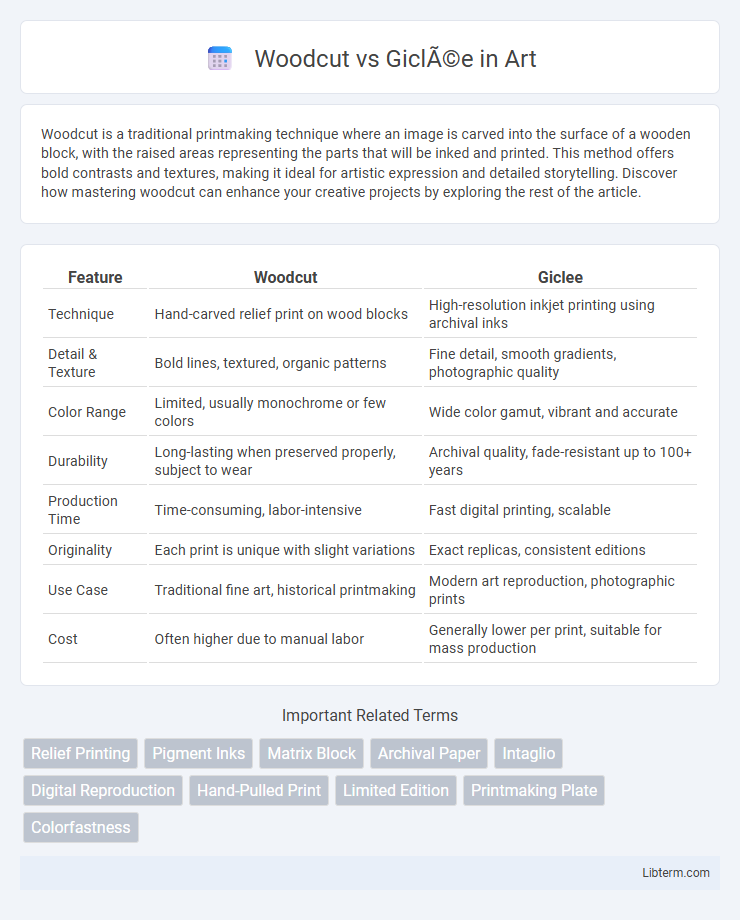Woodcut is a traditional printmaking technique where an image is carved into the surface of a wooden block, with the raised areas representing the parts that will be inked and printed. This method offers bold contrasts and textures, making it ideal for artistic expression and detailed storytelling. Discover how mastering woodcut can enhance your creative projects by exploring the rest of the article.
Table of Comparison
| Feature | Woodcut | Giclee |
|---|---|---|
| Technique | Hand-carved relief print on wood blocks | High-resolution inkjet printing using archival inks |
| Detail & Texture | Bold lines, textured, organic patterns | Fine detail, smooth gradients, photographic quality |
| Color Range | Limited, usually monochrome or few colors | Wide color gamut, vibrant and accurate |
| Durability | Long-lasting when preserved properly, subject to wear | Archival quality, fade-resistant up to 100+ years |
| Production Time | Time-consuming, labor-intensive | Fast digital printing, scalable |
| Originality | Each print is unique with slight variations | Exact replicas, consistent editions |
| Use Case | Traditional fine art, historical printmaking | Modern art reproduction, photographic prints |
| Cost | Often higher due to manual labor | Generally lower per print, suitable for mass production |
Understanding Woodcut Art: Origins and Techniques
Woodcut art, originating in ancient China around the 9th century, involves carving images into wooden blocks to create prints by applying ink and pressing paper onto the surface. This traditional relief printing technique emphasizes bold lines and textures, capturing a handcrafted aesthetic distinct from Giclee prints produced by inkjet technology. Understanding the intricacies of woodcut printing reveals its cultural significance and artistic value compared to modern digital reproductions.
What is Giclée Printing? Technology and Process
Giclee printing is a high-quality inkjet printing process that uses specialized archival inks and printers to produce highly detailed and color-accurate art reproductions. The technology involves spraying microscopic droplets of pigment-based ink onto archival paper or canvas, ensuring longevity and vibrant colors that resist fading. This method is preferred for fine art prints, offering superior resolution and a broader color gamut compared to traditional woodcut prints.
Material Differences: Woodcut Blocks vs Digital Mediums
Woodcut blocks are traditionally carved from hardwoods like cherry or maple, providing a tactile surface that imparts unique textures and depth to the print. Giclee prints utilize digital mediums printed on archival substrates such as heavyweight cotton rag paper or canvas, ensuring high resolution and color fidelity. The physicality of woodcut blocks contrasts with the digital precision of giclee materials, each offering distinct aesthetic qualities and durability.
Visual Aesthetics: Comparing Texture and Detail
Woodcut prints exhibit a distinctive tactile texture with bold, carved lines and a handcrafted feel that emphasizes strong contrasts and organic imperfections. Giclee prints offer superior detail precision and vibrant color gradients through high-resolution inkjet technology, capturing intricate nuances with smooth, photorealistic quality. The visual aesthetics of woodcut prioritize traditional artisanal character, while Giclee excels in fine detail and color fidelity for contemporary art reproduction.
Edition Size and Authenticity in Both Methods
Woodcut prints typically have smaller edition sizes due to the labor-intensive carving and inking process, which enhances their rarity and collector value. Giclee prints allow for larger, high-quality editions using advanced inkjet technology, but the unlimited reproduction potential may affect perceived exclusivity. Authenticity in woodcuts is often verified through the artist's hand-carved signature and unique print characteristics, while giclee prints rely on certificates of authenticity and archival-quality materials to assure provenance.
Longevity and Preservation: Woodcut vs Giclée
Woodcut prints, crafted through traditional relief carving and oil-based inks, generally exhibit exceptional longevity due to their durable materials and resistance to fading when properly cared for. Giclee prints utilize high-quality archival inks on acid-free paper, offering vibrant color retention but can be more vulnerable to light exposure and environmental factors over time. Preservation of woodcuts often involves controlling humidity and avoiding direct sunlight, while giclee prints require specialized framing with UV-protective glass and climate-controlled storage to maximize lifespan.
Artistic Value: Originality and Reproduction
Woodcut prints showcase artistic value through handcrafted originality, each piece reflecting the unique touch and pressure variations applied by the artist, making every print distinct. Giclee reproductions emphasize precision and fidelity, utilizing high-resolution digital printing to replicate original artworks with consistent color accuracy and detail. While woodcuts offer tactile authenticity and singularity, giclee prints prioritize exactness in reproduction, balancing artistic expression with mass accessibility.
Cost Factors: Production and Market Value
Woodcut prints involve labor-intensive carving and manual pressing, resulting in higher initial production costs but limited edition sizes that increase market value due to rarity. Giclee prints use advanced inkjet technology, allowing for cost-effective, high-quality reproductions with quick turnaround and scalability, though their abundance tends to lower individual market prices. Collectors often value woodcuts for craftsmanship and uniqueness, while giclees appeal for precise color accuracy and affordability.
Collectors’ Perspectives: Woodcut or Giclée?
Collectors often value woodcuts for their traditional craftsmanship, tactile texture, and historical significance, which evoke a sense of authenticity and uniqueness in each print. Giclee prints appeal to collectors seeking vibrant colors, high resolution, and longevity due to advanced archival-quality inks and papers. The choice between woodcut and giclee hinges on whether collectors prioritize artisanal heritage or modern precision in their art investments.
Choosing the Right Art Form for Your Space
Woodcut prints offer a tactile, traditional aesthetic with bold lines and textured patterns, ideal for rustic or vintage-inspired spaces seeking a handcrafted feel. Giclee prints provide high-resolution, archival-quality reproductions with vibrant colors and fine details, perfect for modern interiors requiring precise and durable art pieces. Selecting between woodcut and giclee depends on your space's ambiance, desired texture, and longevity preferences.
Woodcut Infographic

 libterm.com
libterm.com